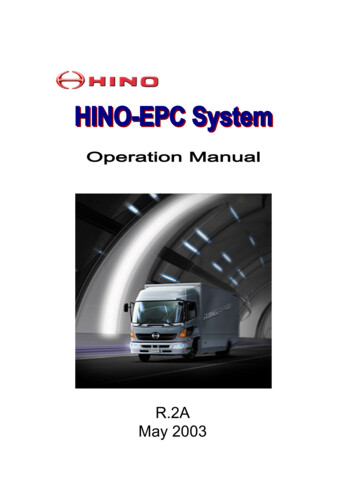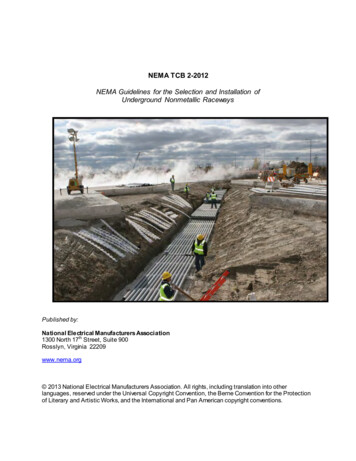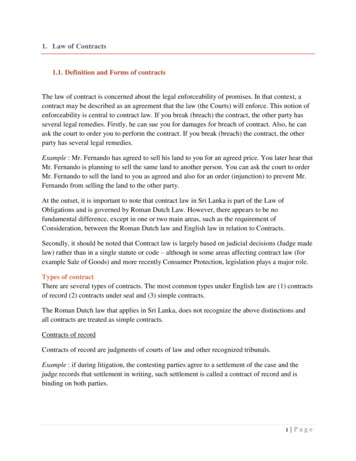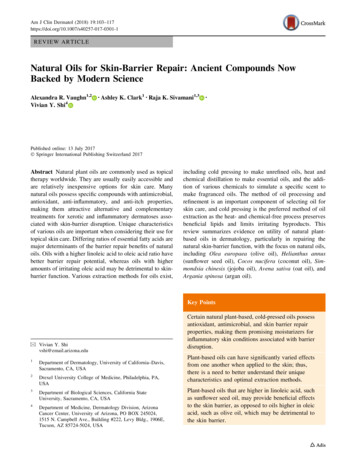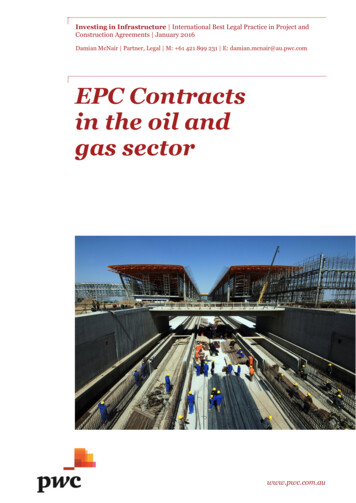
Transcription
Investing in Infrastructure International Best Legal Practice in Project andConstruction Agreements January 2016Damian McNair Partner, Legal M: 61 421 899 231 E: damian.mcnair@au.pwc.comEPC Contractsin the oil andgas sectorwww.pwc.com.au
EPC Contracts in the oil and gassectorIntroductionEngineering, procurement and construction (EPC) contracts are a common form of contract used to undertakeconstruction works by the private sector on large-scale and complex oil and gas projects.1 Under an EPCContract a Contractor is obliged to deliver a complete facility to a Developer who need only turn a key to startoperating the facility, hence EPC Contracts are sometimes called turnkey construction contracts. In addition todelivering a complete facility, the Contractor must deliver that facility for a guaranteed price by a guaranteeddate and it must perform to the specified level. Failure to comply with any requirements will usually result inthe Contractor incurring monetary liabilities.It is timely to examine EPC Contracts and their use in oil and gas projects given the bad publicity they havereceived, particularly in contracting circles. A number of Contractors have suffered heavy losses and, as a result,a number of Contractors now refuse to enter into EPC Contracts in certain jurisdictions. This problem has beenexacerbated by a substantial tightening in the insurance market. Further, some project proponents believe thatthe project delivery methods such as engineering, procurement, and construction management (EPCM)contracts give them greater flexibility and that they have the expertise and experience required to control costsin an EPCM Contract.However, because of their flexibility, the value and the certainty Sponsors and Lenders derive from EPCContracts, the authors believe EPC Contracts will continue to be a pre-eminent form of construction contractused on large-scale oil and gas projects in most jurisdictions.2This paper will only focus on the use of EPC Contracts in the oil and gas sector. However, the majority of theissues raised are applicable to EPC Contracts used in all sectors.Prior to examining power project EPC Contracts in detail, it will be useful to explore the basic features of an oiland gas project.1By this we mean oil, gas and derivatives of the same such as methanol, fertiliser etc. See also David Roe, LNG Trade: A Review of Markets, Projects andIssues in the Changing World of LNG, (SMI Publishing Ltd, 2003), 119.2Some jurisdictions, such as the USA, use alternative structures which separate the work into various components.PwC3
EPC Contracts in the oil and gas sectorBasic features of an oil and gas projectThe contractual structureThe diagram below illustrates the basic contractual structure of a simple project-financed oil and gas projectusing an EPC Contract.3Joint ventureEquity SupportAgreementsOperating AgreementFinancing and SecurityAgreementsProject Company/Oil and GasField OperatorEPC ContractEPC ContractorO&M ContractO&M ContractorLendersOfftake AgreementOil and Gas SupplierOff takerPossibly one or more ofthe JV participantsTripartite AgreementsThe detailed contractual structure will vary from project to project. However, most projects will have the basicstructure illustrated above.4 As can be seen from the diagram, the operating company will usually enter intoagreements which cover the following elements: An operating agreement with the joint venture (JV) participants which gives the operating company theright to construct and operate the oil and gas facility. Usually, each JV participant will sell its own share ofthe product. This is even the case if participants jointly market the product. Traditionally the operatingagreement is a joint operating agreement (JOA) between the JV participants whereby one of theparticipants operates the facility.There is a significant advantage in this structure as it means that one body is responsible for the delivery ofprojects, relationships with government, customers and Contractors. The JOA governs how liability isspread amongst participants with respect to any liabilities or obligations incurred by the Operator.Generally, the participants have several liabilities and the Operator makes cash calls on them in proportionto their respective JV shares to fund capital expenditure. A special purpose vehicle can also be created tofulfil this role but usually the control of this vehicle will be in the hands of one of the JV participants. Many oil and gas companies have the ability to use corporate finance from the balance sheet, however this isnot always the case. There are a number of smaller oil and gas companies looking to develop assets that areregarded as stranded or too small for the larger companies to operate profitably. These companies requirefinance to carry out these developments. In these cases, the EPC Contractor must be a large, experiencedparticipant in the industry which the Sponsors and Lenders are confident can successfully deliver theproject, and is large enough to cope with losses if it does not. Further, companies with a successful trackrecord mean that insurance for the project is easier to obtain. The larger Owners will still use an EPCContract or design and construct contract for parts of large projects even if self-management, EPCM or otherproject management contracts are used for the balance of the project.3An LNG project would also usually involve a shipping deal and/or pipeline aspects.4Even if the project is developed by a large conglomerate there are usually contracts between the various entities. For example, where the proponent will alsobe the supplier there will often be a supply agreement put in place so that the new project is properly defeasible and business property accountablePwC4
EPC Contracts in the oil and gas sector There are a number of contractual approaches that can be taken to construct an oil and gas facility. An EPCContract is one approach. Another option is to have a supply contract, a design agreement and constructioncontract with or without a project management agreement. The project management can be, and often is,carried out by the proponent itself. Alternatively, an EPCM or other project management contract can beused for managing the project. The choice of contracting approach will depend on a number of factorsincluding the time available, the Lender’s requirements, the sophistication of the proponent, and the identityof the Contractor(s). The major advantage of the EPC Contract over the other possible approaches is that itprovides for a single point of responsibility. This is discussed in more detail below.Interestingly, on large project-financed derivative projects the Contractor is increasingly becoming one ofthe Sponsors (ie an equity participant) in the Project Company. This is not the case in traditional oil and gasprojects. Contractors will ordinarily sell down their interest after financial close because, generally speaking,Contractors will not wish to tie up their capital in operating projects. In addition, once construction iscomplete the rationale for having the Contractor included in the Ownership consortium often no longerexists. Similarly, once construction is complete a project will normally be reviewed as lower risk than aproject in construction, therefore, all other things being equal, the Contractor should achieve a good returnon its investments. Large overarching operating and maintenance agreements (O&M Agreements) are uncommon in the oiland gas industry. Industry participants are generally in the business of managing these facilities. However,components of the operations are usually contracted out. Offtake agreements govern the sale of the product of the project. For gas projects and hydrocarbonderivative projects these agreements are crucial to the development proceeding. Financiers will not lend thefunds and boards will not approve the project if there are no customers locked in to take the product. Theimpact of the offtake agreement is on practical completion. If there are take or pay agreements it is vital thatthe project is ready to deliver product from inception date of the offtake agreement or it will face penalties. Itmay even have to buy product on the open market to meet its obligations. As these markets are usuallythinly traded these can be a costly exercise. Oil projects can be underpinned by long-term contracts but it isnot the norm. Financing and security agreements with the Lenders to finance the development of the project.Accordingly, the construction contract is only one of a suite of documents on an oil and gas project.Importantly, the promoter or the JV participants of the project operate and earn revenues under contracts otherthan the construction contract. Therefore, the construction contract must, where practical, be tailored so as tobe consistent with the requirements of the other project documents. As a result, it is vital to properly managethe interfaces between the various types of agreements. These interface issues are discussed in more detail laterin this paper.BankabilityA bankable contract is a contract with a risk allocation between the Contractor and the Project Company thatsatisfies the Lenders. Lenders focus on the ability (or more particularly the lack thereof) of the Contractor toclaim additional costs and/or extensions of time as well as the security provided by the Contractor for itsperformance. The less comfortable the Lenders are with these provisions the greater amount of equity supportthe Sponsors will have to provide. In addition, Lenders will have to be satisfied as to the technical risk.Obviously price is also a consideration but that is usually considered separately to the bankability of thecontract because the contract price (or more accurately the capital cost of the project facility) goes more directlyto the economic bankability of the project as a whole.Before examining the requirements for bankability it is worth briefly considering the appropriate financingstructures and lending institutions. Historically, the most common form of financing for oil and gas projects isproject financing. Project financing is a generic term that refers to financing secured only by the assets of theproject itself. Therefore, the revenue generated by the project must be sufficient to support the financing.Project financing is also often referred to as either “non-recourse” financing or “limited recourse” financing.The terms “non-recourse” and “limited recourse” are often used interchangeably, however, they mean differentthings. “Non-recourse” means there is no recourse to the project Sponsors at all and “limited recourse” means,as the name suggests, there is limited recourse to the Sponsors. The recourse is limited both in terms of when itPwC5
EPC Contracts in the oil and gas sectorcan occur and how much the Sponsors are forced to contribute. In practice, true non-recourse financing is rare.In most projects the Sponsors will be obliged to contribute additional equity in certain defined situations.Traditionally, project financing was provided by commercial Lenders. However, as projects became morecomplex and financial markets more sophisticated project finance also developed. In addition, as well as bankborrowings, Sponsors are also using more sophisticated products like credit-wrapped bonds, securitisation offuture cash flows and political, technical and completion risk insurance to provide a portion of thenecessary finance.In assessing bankability, Lenders will look at a range of factors and assess a contract as a whole. Therefore, inisolation it is difficult to state whether one approach is or is not bankable. However, generally speaking, theLenders will require the following: a fixed completion date a fixed completion price no or limited technology risk output guarantees liquidated damages for both delay and performance security from the Contractor and/or its parent large caps on liability (ideally, there would be no caps on liability, however, given the nature of EPCContracting and the risks to the Contractors involved there are almost always caps on liability) restrictions on the ability of the Contractor to claim extensions of time and additional costs.An EPC Contract delivers all of the requirements listed above in one integrated package. This is one of themajor reasons why they are the predominant form of construction contract used on large-scale project financedinfrastructure projects and why they can be effective on a variety of oil and gas projects.Basic features of an EPC ContractThe key clauses in any construction contract are those which impact on: time cost quality.The same is true of EPC Contracts. However, EPC Contracts tend to deal with issues with greater sophisticationthan other types of construction contracts. This is because, as mentioned above, an EPC Contract is designed tosatisfy the Lenders’ requirements for bankability.EPC Contracts provide for: A single point of responsibility: The Contractor is responsible for all design, engineering, procurement,construction, commissioning and testing activities. Therefore, if any problems occur the Project Companyneed only look to one party – the Contractor – to fix the problem and provide compensation. As a result, ifthe Contractor is a consortium comprising several entities the EPC Contract must state that those entitiesare jointly and severally liable to the Project Company. A fixed contract price: Risk of cost overruns and the benefit of any cost savings are to the Contractor’saccount. The Contractor usually has a limited ability to claim additional money which is limited toPwC6
EPC Contracts in the oil and gas sectorcircumstances where the Project Company has delayed the Contractor or has ordered variations tothe works. A fixed completion date: EPC Contracts include a guaranteed completion date that is either a fixed dateor a fixed period after the commencement of the EPC Contract. If this date is not met the Contractor is liablefor delay liquidated damages (DLDs). DLDs are designed to compensate the Project Company for loss anddamage suffered as a result of late completion of the facility. To be enforceable in common law jurisdictions,DLDs must be a genuine pre-estimate of the loss or damage that the Project Company will suffer if thefacility is not completed by the target completion date. The genuine pre-estimate is determined by referenceto the time the contract was entered into.DLDs are usually expressed as a rate per day which represents the estimated extra costs incurred (such asextra insurance, supervision fees and financing charges) and losses suffered (revenue forgone) for each dayof delay. In addition, the EPC Contract must provide for the Contractor to be granted an extension of timewhen it is delayed by the acts or omissions of the Project Company. Performance guarantees: The Project Company’s revenue will be earned by operating the facility.Therefore, it is vital that the facility performs as required in terms of output, efficiency and reliability.Therefore, EPC Contracts contain performance guarantees backed by performance liquidated damages(PLDs) payable by the Contractor if it fails to meet the performance guarantees.PLDs must also be a genuine pre-estimate of the loss and damage that the Project Company will suffer overthe life of the project if the facility does not achieve the specified performance guarantees. As with DLDs, thegenuine pre-estimate is determined by reference to the time the contract was signed.It is possible to have a separate contract that sets out the performance requirements, testing regime andremedies. However, this can create problems where the EPC and the performance guarantees do not match. Inour view, the preferred option is to have the performance guarantees in the EPC Contract itself.PLDs and the performance guarantee regime and its interface with the DLDs and the delay regime is discussedin more detail in the section on key performance clauses. Caps on liability: As mentioned above most EPC Contractors will not, as a matter of company policy, enterinto contracts with unlimited liability. Therefore, EPC Contracts for oil and gas projects cap the Contractor’sliability at a percentage of the contract price. This varies from project to project, however, a cap of 100percent of the contract price is common. In addition, there are normally subcaps on the Contractor’sliquidated damages liability. For example, DLDs and PLDs might each be capped at 20 percent of thecontract price with an overall cap on both types of liquidated damages of 30 percent of the contract price.There will also likely be a prohibition on the claiming of consequential losses. Put simply, consequentiallosses are those losses which do not flow directly from a breach of contract but which were in the reasonablecontemplation of the parties at the time the contract was entered into. This used to mean heads of damagelike loss of profit. However, loss of profit is now usually recognised as a direct loss on project-financedprojects and, therefore, would be recoverable under a contract containing a standard exclusion ofconsequential loss clause. Nonetheless, care should be taken to state explicitly that liquidated damages caninclude elements of consequential loss. Given the rate of liquidated damages is pre-agreed most Contractorswill not object to this exception.In relation to both caps on liability and exclusion of liability it is common for there to be some exceptions.The exceptions may apply to either or both the cap on liability and the prohibition on claiming consequentiallosses. The exceptions themselves are often project specific, however, some common examples include casesof fraud or wilful misconduct, in situations where the minimum performance guarantees have not been metand the cap on delay liquidated damages has been reached and breaches of the intellectualproperty warranties. Security: It is standard for the Contractor to provide performance security to protect the Project Companyif the Contractor does not comply with its obligations under the EPC Contract. The security takes a numberof forms including:PwC7
EPC Contracts in the oil and gas sector– A bank guarantee or bond for a percentage, normally in the range of 5–15 percent, of the contract price.The actual percentage will depend on a number of factors including the other security available to theProject Company, the payment schedule (because the greater the percentage of the contract price unpaidby the Project Company at the time it is most likely to draw on security ie to satisfy DLD and PLDobligations the smaller the bank guarantee can be), the identity of the Contractor and the risk of it notproperly performing its obligations, the price of the bank guarantee and the extent of the technology risk.– Retention ie withholding a percentage (usually 5–10 percent) of each payment. Provision is often made toreplace retention monies with a bank guarantee (sometimes referred to as a retention guarantee (bond).– Advance payment guarantee, if an advance payment is made.– A parent company guarantee – this is a guarantee from the ultimate parent (or other suitable relatedentity) of the Contractor which provides that it will perform the Contractor’s obligations if, for whateverreason, the Contractor does not perform. Variations: The Project Company has the right to order variations and agree to variations suggested by theContractor. If the Project Company wants the right to omit works either in their entirety or to be able toengage a different Contractor this must be stated specifically. In addition, a properly drafted variationsclause should make provision for how the price of a variation is to be determined. In the event the parties donot reach agreement on the price of a variation the Project Company or its representative should be able todetermine the price. This determination is subject to the dispute resolution provisions. In addition, thevariations clause should detail how the impact, if any, on the performance guarantees is to be treated. Forsome larger variations the Project Company may also wish to receive additional security. If so, this must alsobe dealt with in the variations clause. Defects liability: The Contractor is usually obliged to repair defects that occur in the 12 to 24 monthsfollowing completion of the performance testing. Defects liability clauses can be tiered ie the clause canprovide for one period for the entire facility and a second, extended period, for more critical items. Intellectual property: The Contractor warrants that it has rights to all the intellectual property used inthe execution of the works and indemnifies the Project Company if any third parties’ intellectual propertyrights are infringed. Force majeure: The parties are excused from performing their obligations if a force majeure event occurs. Suspension: The Project Company usually has the right to suspend the works. Termination: This sets out the contractual termination rights of both parties. The Contractor usually hasvery limited contractual termination rights. These rights are limited to the right to terminate for nonpayment or for prolonged suspension or prolonged force majeure and will be further limited by the tripartiteor direct agreement between the Project Company, the Lenders and the Contractor. The Project Companywill have more extensive contractual termination rights. They will usually include the ability to terminateimmediately for certain major breaches or where the Contractor becomes insolvent, and the right toterminate after a cure period for other breaches. In addition, the Project Company may have a right toterminate for convenience. It is likely the Project Company’s ability to exercise its termination rights willalso be limited by the terms of the financing agreements. Performance specification: Unlike a traditional construction contract, an EPC Contract usually containsa performance specification. The performance specification details the performance criteria that theContractor must meet, but does not dictate how they must be met. This is left to the Contractor todetermine. A delicate balance must be maintained. The specification must be detailed enough to ensure theProject Company knows what it is contracting to receive but not so detailed that if problems arise theContractor can argue they are not its responsibility.Whilst there are, as described above, numerous advantages to using an EPC Contract, there are somedisadvantages. These include the fact that it can result in a higher contract price than alternative contractualstructures. This higher price is a result of a number of factors not least of which is the allocation of almost allthe construction risk to the Contractor. This has a number of consequences, one of which is that the ContractorPwC8
EPC Contracts in the oil and gas sectorwill have to factor in to its price the cost of absorbing those risks. This will result in the Contractor buildingcontingencies into the contract price for events that are unforeseeable and/or unlikely to occur. If thosecontingencies were not included the contract price would be lower. However, the Project Company would bearmore of the risk of those unlikely or unforeseeable events. Sponsors have to determine, in the context of theirparticular project, whether the increased price is worth paying.As a result, Sponsors and their advisers must critically examine the risk allocation on every project. Riskallocation should not be an automatic process. Instead, the Project Company should allocate risk in asophisticated way that delivers the most efficient result. For example, if a project is being undertaken in an areawith unknown geology and without the time to undertake a proper geotechnical survey, the Project Companymay be best served by bearing the site condition risk itself as it will mean the Contractor does not have to pricea contingency it has no way of quantifying. This approach can lower the risk premium paid by the ProjectCompany. Alternatively, the opposite may be true. The Project Company may wish to pay for the contingency inreturn for passing on the risk which quantifies and caps its exposure. This type of analysis must be undertakenon all major risks prior to going out to tender.Another consequence of the risk allocation is the fact that there are relatively few engineering and constructioncompanies that can and are willing to enter into EPC Contracts. As mentioned in the Introduction some badpublicity and a tightening insurance market have further reduced the pool of potential EPC Contractors. Thescarcity of EPC Contractors can also result in relatively high contract prices.Another major disadvantage of an EPC Contract becomes evident when problems occur during construction. Inreturn for receiving a guaranteed price and a guaranteed completion date, the Project Company cedes most ofthe day-to-day control over the construction. Therefore, Project Companies have limited ability to intervenewhen problems occur during construction. The more a Project Company interferes during the construction, thegreater the likelihood of the Contractor claiming additional time and costs. In addition, interference by theProject Company will make it substantially easier for Contractors to defeat claims for liquidated damages anddefective works.Obviously, ensuring the project is completed satisfactorily is usually more important than protecting theintegrity of the contractual structure. However, if a Project Company interferes with the execution of the worksthey will, in most circumstances, have the worst of both worlds. They will have a contract that exposes them toliability for time and costs incurred as a result of their interference without any corresponding ability to holdthe Contractor liable for delays in completion or defective performance. The same problems occur even wherethe EPC Contract is drafted to give the Project Company the ability to intervene. In many circumstances,regardless of the actual drafting, if the Project Company becomes involved in determining how the Contractorexecutes the works then the Contractor will be able to argue that it is not liable for either delayed ordefective performance.As a result, it is vitally important that great care is taken in selecting the Contractor and in ensuring theContractor has sufficient knowledge and expertise to execute the works. Given the significant monetary value ofEPC Contracts, and the potential adverse consequences if problems occur during construction, the lowest priceshould not be the only factor used when selecting Contractors.PwC9
EPC Contracts in the oil and gas sectorSplit EPC ContractParticularly in the Middle East and South Asia region (eg Egypt, India), one common variation to the basic EPCContract structure illustrated above is a split EPC Contract. Under a split EPC Contract, the EPC Contract is, asthe name implies, split into two or more separate contracts. The basic split structure involves splitting the EPCContract into an onshore construction contract and an offshore supply contract:GuarantorWrap-AroundGuaranteeProject ntractOffshoreContractorExample simple split EPC Contract structureThere are two main reasons for using a split contract. The first is because it can result in a lower contract priceas it allows the Contractor to make savings in relation to onshore taxes, in particular on indirect and corporatetaxes in the onshore jurisdiction. The second is because it may reduce the cost of complying with local licensingregulations by having more of the works, particularly the design works, undertaken offshore.5 In addition, insome countries which impose restrictions on who can carry out certain activities like engineering and designservices, splitting the EPC Contract can also be advantageous because it can make it easier to repatriate profits.Below is a diagram illustrating a more complex split EPC structure we have used previously that dealt with bothtax and licensing issues.Example complex split EPC Contract structureWhilst a split EPC Contract can result in cost savings, there are risks to the Project Company in using such astructure. This mainly arises because of the derogation from the principle of single point responsibility.5We have prepared a paper that deals with the variations and complications in split EPC contracts in the MESA region. You should consult that paper if youwant more information on this topic.PwC10
EPC Contracts in the oil and gas sectorGuarantorWrap-AroundGuaranteeOffshore GuarantorGuaranteeAgreementProject Company B(only onshore entity)GuaranteeAgreementEquipmentSupply ContractDesignAgreementC(an offshore entity)C(an offshore entity)Onshore GuarantorProject ManagementAgreementConstructionContractDesign ReviewContractD(an offshore entity)E(an offshore entity)F(an offshore entity)Unlike a standard EPC Contract, the Project Company cannot look only to a single Contractor to satisfy all thecontractual obligations (in particular, design, construction and performance). Under a split structure, there areat least two entities with those obligations. Therefore, a third agreement, a wrap-around guarantee,6 is used todeliver a single point of responsibility despite the split.Under a wrap-around guarantee, an entity, usually either the offshore Supplier or the parent company of thecontracting entities, guarantees the obligations of both Contractors. This delivers a single point of responsibilityto the Project Company and the Lenders. The contracting entities will then enter into a separate agreement todetermine how, as between themselves, liability is to be apportioned. However, that agreement is not relevantfor the purposes of this paper.In addition, the wrap-around guarantee will, if properly drafted, prevent the various
Many oil and gas companies have the ability to use corporate finance from the balance sheet, however this is not always the case. There are a number of smaller oil and gas companies looking to develop assets that are regarded as stranded or too small for the larger
